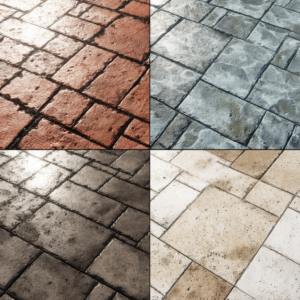Travertine pavers are a popular choice for outdoor flooring due to their durability, natural beauty, and versatility. However, during the installation process, you may need to know how to cut travertine pavers. So how can we do that as easiest and safest as possible?
In this article, we will provide you with a comprehensive guide on how to cut travertine pavers effectively, while maintaining their integrity and aesthetic appeal. We will also focus on safety and detailed explanations for first-timers. So let’s get going!
Don’t miss: How to Seal Travertine Pavers – A Step-by-Step Guide
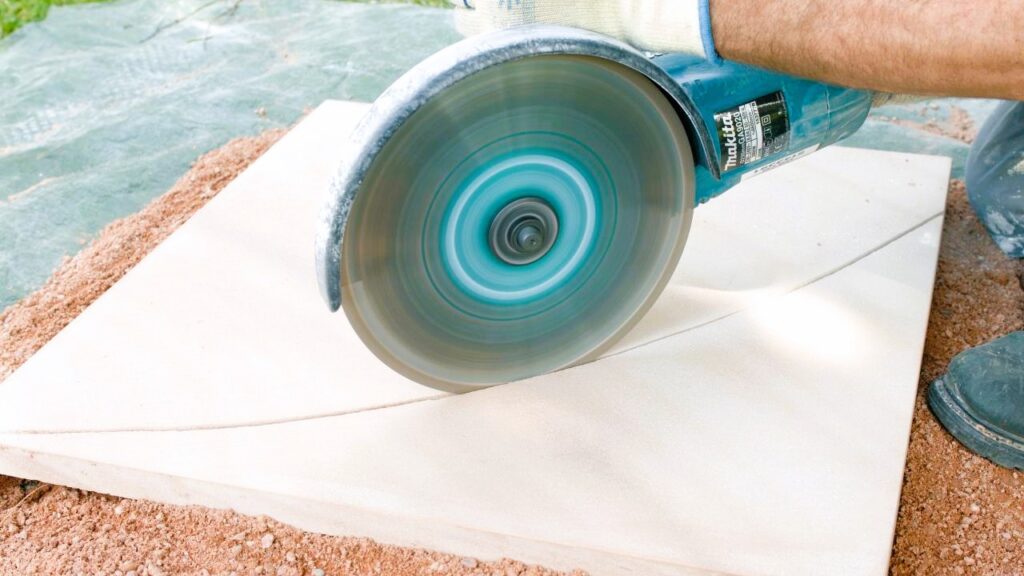
Jump to:
How to cut travertine pavers: before you begin
Safety first. That’s the word of order – and a non-negotiable one at that.
Always wear safety goggles or a face shield to protect your eyes from flying debris. Additionally, wear ear protection to reduce the noise generated by cutting equipment and work gloves to protect your hands.
Select the right tool for cutting pavers, such as a diamond-blade wet saw, an angle grinder with a diamond blade, or a brick splitter. Ensure the tool is in good working condition and follow the manufacturer’s instructions.
Set up your work area on a stable, flat surface. Remove any obstructions or debris that could cause accidents or interfere with your work. Keep the area clear of bystanders or pets.
Make sure you have all the equipment organized and checked near you. Here is a list of the materials you’re going to need:
- Tape measure;
- Chalk or pencil;
- Straightedge or level;
- Water source (for performing the wet saw technique).
Choosing the right cutting tool
Choosing the right cutting tool for cutting pavers depends on the following factors:
- Paver type: Different cutting tools are designed to work with specific types of pavers, so ensure that the tool you choose is compatible with the material you are working with. In your case, that will be travertine which is a softer natural stone, so take that into account.
- Cutting method: Determine whether you need straight cuts, curved cuts, or more complex shapes, as this will help you select the appropriate tool.
- Project scale: Consider the size of the project and the frequency of paver cutting. For larger projects, investing in or renting a specialized tool like a wet saw may be more cost-effective and efficient.
With those aspects in mind, you can choose the cutting method that suits you best.
- Wet Saw (recommended)
A wet saw is a common choice for cutting pavers. It uses a diamond-tipped blade and water to cool the blade and reduce dust. Wet saws are effective for straight cuts and can handle different types of pavers, such as concrete, stone, or brick. - Angle Grinder
An angle grinder with a diamond blade is another option. It is versatile and suitable for both straight cuts and curved or intricate shapes. However, angle grinders don’t come with an embedded water system like the wet saw, so you’ll need to improvise that. We will talk more about this aspect ahead. - Masonry Chisel and Hammer
If you need to make only a few rough and straight cuts, you can use a masonry chisel and a hammer. Score the paver along the desired cutting line with the chisel, and then strike the chisel with the hammer to split the paver along the scored line. This method is labor-intensive and may not provide the cleanest cuts. - Guillotine Paver Splitter
For straight cuts on thicker pavers, a guillotine paver splitter can be efficient. This tool has a lever mechanism that applies pressure to split the paver along the desired line. It’s suitable for clay and some concrete pavers. - Circular Saw
In some cases, a circular saw with a masonry blade can be used for cutting pavers. This option is more suitable for larger projects where precise cuts are not critical. By using a circular saw, you’ll have the same problems as with the angle grinder, so let’s discuss that problem.
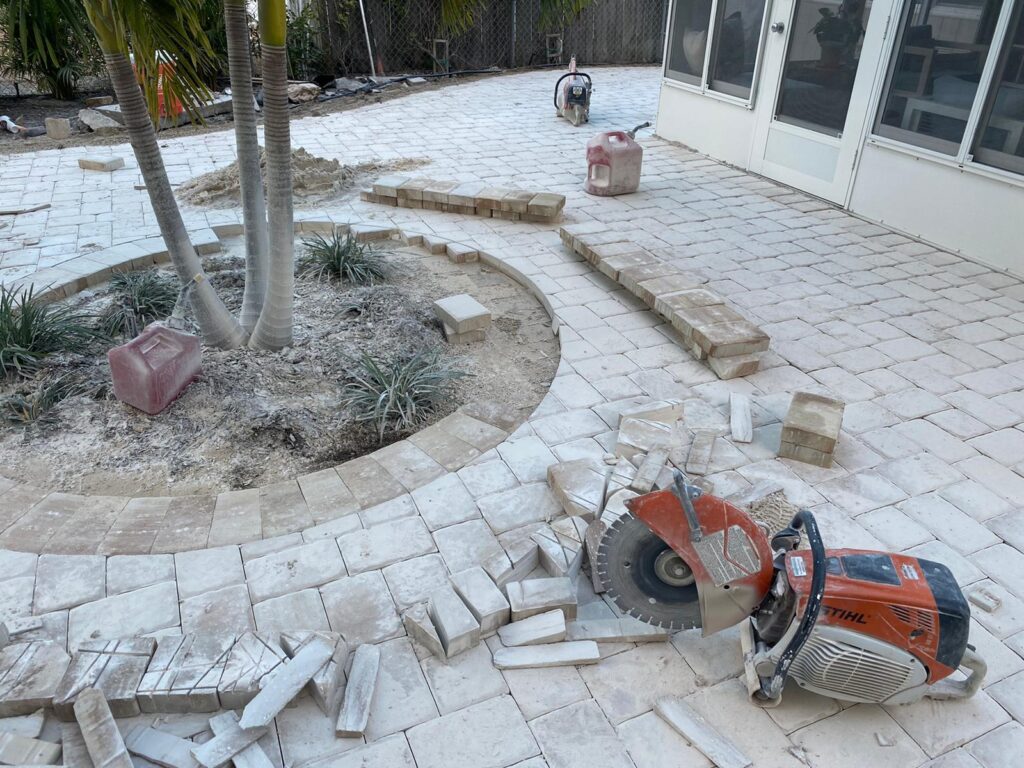
About the wet-cut technique
The wet cutting technique refers to using water in combination with saws to cut through materials such as pavers, tiles, or stone. The water source is used to cool the blade and suppress dust during the cutting process.
The dust that comes from cutting pavers is dangerous, as it contains silica, which is extremely prejudicial to your health if inhaled. In most areas, it is forbidden to cut masonry materials without using this technique.
That’s why the wet saw is recommended – because it has an embedded water system to perform that job optimally. With other saws, you’ll probably need someone’s help to keep watering the paver with a garden hose or something similar as you cut it.
How to cut travertine pavers: step by step
Now, let’s dive into the step-by-step process of cutting travertine pavers. Let’s start with measuring and marking.
Accurate measurements are crucial for achieving precise cuts. Use a tape measure to determine the dimensions you need for the travertine paver. Mark the measurements on the paver’s surface with chalk or pencil.
For straight cuts, use a straightedge or level to draw a straight line connecting the marked points. This line will serve as a guide for cutting.
Now, things will greatly depend on the cutting method you choose.
Hammer and chisel
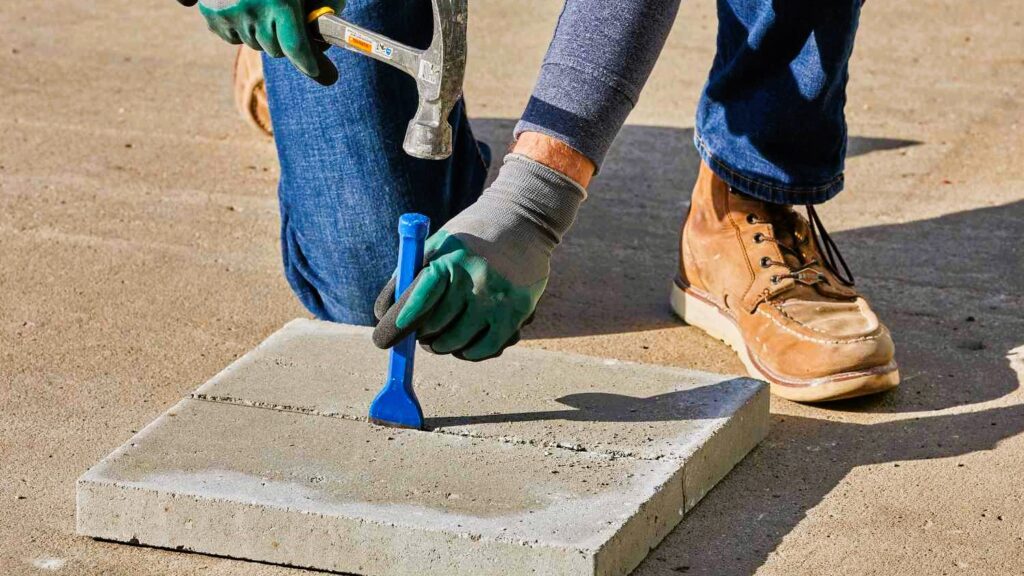
If you’re using a chisel and hammer, take the chisel and place it on the marked line. Hold the chisel at a slight angle, with the beveled side facing the waste side of the paver. Gently tap the chisel with the hammer to create a shallow groove along the entire cut line.
Continue tapping the chisel along the cut line, gradually increasing the force to deepen the groove. Make multiple passes along the line until the groove is approximately 1/8 to 1/4 inches deep.
Position the chisel on the waste side of the paver and apply a firm, controlled strike with the hammer on the chisel to split the paver along the cut line. Start with lighter strikes and gradually increase the force until the paver splits.
After splitting the paver, use the chisel and hammer to clean up any rough edges or uneven sections.
Guillotine Paver Splitter
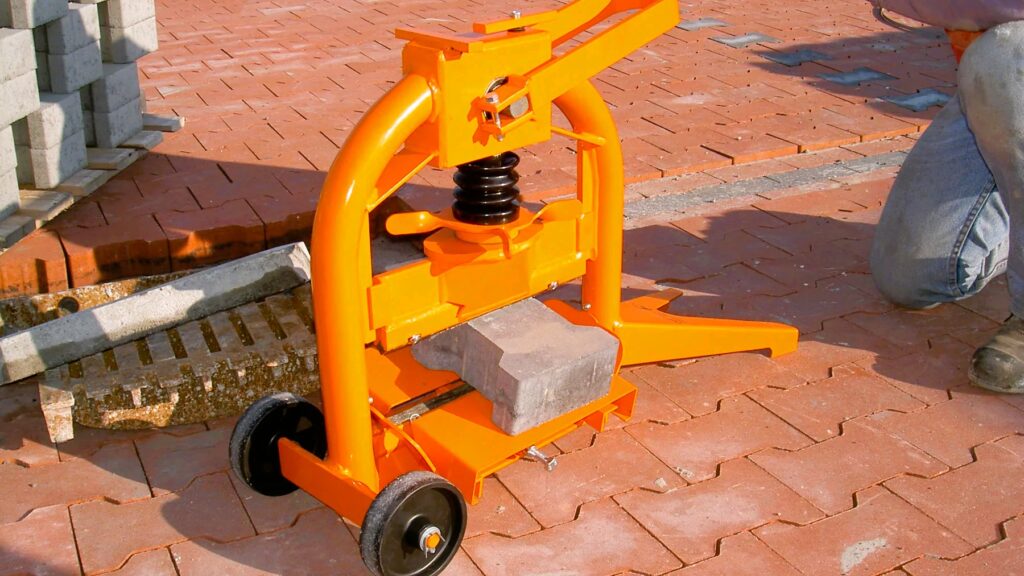
The guillotine paver splitter is a much more efficient and precise method for cutting pavers compared to using a hammer and chisel.
Start by placing the guillotine paver splitter on a stable and level surface. Make sure it is securely positioned and won’t move during the cutting process.
Adjust the guillotine blade height to match the thickness of the paver you want to cut. Refer to the manufacturer’s instructions for the specific model you are using.
Place the paver on the guillotine, aligning the marked cutting line with the blade of the guillotine. Ensure that the paver is positioned securely and won’t move during cutting.
Depending on the type of guillotine paver splitter you are using, follow the manufacturer’s instructions to activate the cutting mechanism. This may involve using a lever, handle, or foot pedal to bring down the blade onto the paver.
Apply steady and even pressure to the guillotine, allowing the blade to cut through the paver along the marked line. Keep your hands clear of the cutting area and use caution while operating the guillotine.
Once the paver is cut, remove it from the guillotine. Use a brush or broom to remove any debris or dust from the cutting area and the paver.
Angle grinder and circular saw

The process of cutting pavers using these two tools is very similar.
Place the paver on a stable and level work surface. It’s recommended to use a workbench or sawhorse to support the paver during cutting. Use clamps or a vise grip to secure the paver in place, ensuring it won’t move while you’re cutting.
Ensure the machine is equipped with an appropriate diamond blade. Start it and allow it to reach its maximum speed before beginning the cut. Position the blade aligned with the marked cut line. Gently lower the blade onto the paver, applying light pressure.
With a steady hand, slowly move the blade along the marked cut line, allowing it to cut through the paver. Let the machine do the work and avoid forcing the blade through the material. Take your time to ensure an accurate and clean cut.
Once the cut is complete, turn off the machine and let the blade come to a complete stop before setting it down. Use a chisel or sandpaper to smooth any rough edges or uneven surfaces.
Wet saw
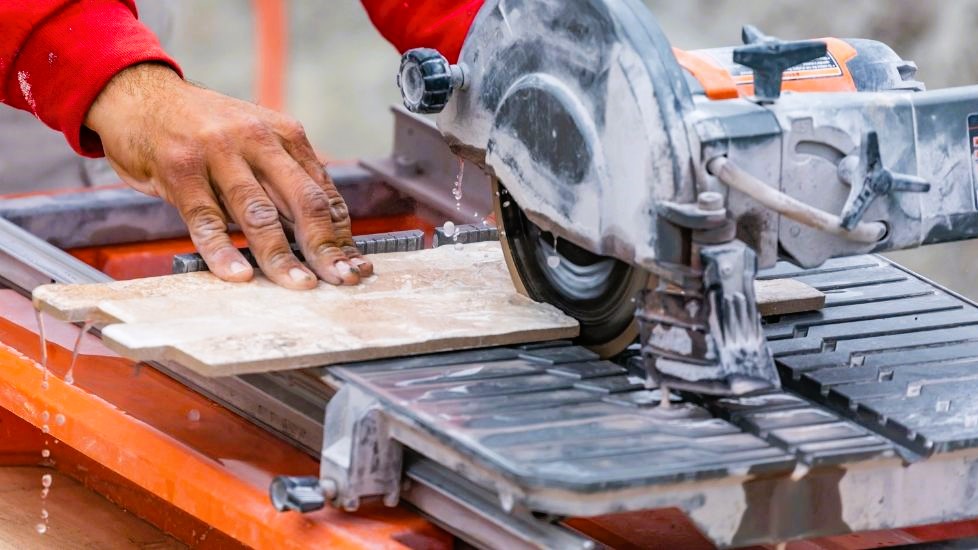
Now what is considered the best method to cut pavers: the wet saw is a popular and efficient method that provides clean and precise cuts.
Place the wet saw on a stable and level surface, preferably outdoors or in a well-ventilated area. Ensure that the water reservoir is filled according to the manufacturer’s instructions.
Adjust the cutting depth and angle of the wet saw to match the thickness and angle of the cut you want to make. Refer to the manufacturer’s instructions for your specific wet saw model.
Place the paver on the work surface, aligning the marked cutting line with the blade of the wet saw. Ensure that the paver is positioned securely and won’t move during cutting.
Turn on the wet saw and wait for the blade to reach its maximum speed before beginning the cut. With a steady hand, slowly feed the paver into the wet saw, allowing the diamond blade to cut through the material along the marked line.
Let the wet saw do the work and avoid forcing the paver through the blade. Maintain a smooth and steady pace throughout the cut.
Once the cut is complete, turn off the wet saw and let the blade come to a complete stop before setting it down.
Professional help on how to cut travertine pavers
And there you go! With these tips, you should be ready to cut your travertine pavers.
It may seem challenging at first, but with the right tools, techniques, and safety precautions, you can achieve precise and good-looking results. Remember to measure accurately, wear safety equipment, and take your time while cutting.
But, of course, nothing replaces professional work, so consider hiring a professional hardscape contractor in your area to help you.
We here at JS Brick, throughout our 23 years of experience, have helped homeowners with their pavers installation too many times to count. We know how tricky cutting pavers may sometimes get, and that’s why we always recommend asking for professional help if possible.
And if you happen to be around our area of activity – Sarasota County, in FL – get in touch with us to help you with your project. We would be glad to add you to our long list of satisfied customers!


